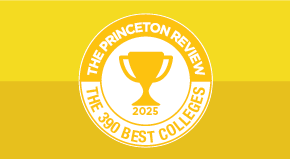
To successfully accomplish any task, you need to know the structure or framework of what you're trying to do. If you have a written assignment for school, you want to know how many words or pages your teacher expects. If you’re running a race, you want to know how far you’re running. And, with the Digital SAT, you want to know the structure of the test.
As you prepare for the Digital SAT, you’ll not only want to learn the content that will appear on the test but also strategies that will lead you to your best possible score. To apply this knowledge, you need to know what shows up and in what order on the Digital SAT. Furthermore, strategies, such as Personal Order of Difficulty, can be applied to how you approach each module.
Layout
Once you’ve started the test, you’ll see one question at a time.
Reading and Writing: The left-hand side will be the passage associated with the current question. (Note that each question has its own passage.) The right-hand side of the screen will have the questions and answer choices. The Annotate tool lets you highlight parts of the text and question, as well as make notes on the screen.
Math: Multiple-choice questions will be centered on the screen, with the answer choices below the question. For student-produced response questions, the left-hand side of the screen will have the instructions for entering your answers, and the right-hand side will have the question and the answer box. This section also has a built-in Calculator (a version of the Desmos calculator that you may have used for school) and Reference Sheet (which provides a number of geometry formulas and rules).
Notable Points
-
On every question, you’ll have the ability to navigate to any question in the section by clicking on the black box in the middle of the bottom of the screen.
-
“Back” and “Next” buttons can be found on the lower-right corner of the screen.
-
On all multiple-choice questions, you’ll have access to the Option Eliminator tool.
-
On all Reading and Writing questions and Math student-produced response questions, the divider between the passage or instructions on the left and question and answer choices on the right can be dragged and adjusted.
Sections
The Digital SAT has two sections. The first section is Reading and Writing, and the second section is Math. You will earn a separate score of 200-800 for Reading and Writing and for Math. These scores are added to determine your total score from 400-1600.
Each of these two sections has two modules. Within each module, you can move back and forth from question to question, but you cannot go back to previous modules. This is because the Digital SAT is an adaptive test.
Adaptive Modules
The first module of each section of the Digital SAT will be a roughly equal mix of easy, medium, and difficult questions. Depending on your performance on the first module, you’ll receive either an easier or harder second module. If you do well on the first module, you’ll get a second module that has only a few easy questions and more difficult questions than the first module. If you don’t do as well, you’ll get a second module with more easy questions and fewer difficult questions.
Your final score in each section is not only determined by how many questions you get correct but also by which second module you receive. If you get the harder second module, you’ll have a floor to how low you can score overall. If you get the easier second module, there will be a cap to your highest possible score.
Reading and Writing
The two Reading and Writing modules have the same overall structure. Each module has 27 questions; 25 of these questions count towards your score (what the College Board refers to as “operational questions”), whereas the other 2 questions are experimental (“pretest questions”). You will have 32 minutes to complete these questions.
Within each module, the order of the questions will be the same. Reading questions come first, followed by Writing questions.
The Reading questions fall into seven categories:
-
Vocabulary
-
Purpose
-
Dual Texts
-
Retrieval
-
Main Idea
-
Claims
-
Conclusions
Not every module will contain all seven categories, but the categories that do appear will be in that order. Typically, 13-17 of the Reading and Writing questions will be Reading.
The remaining 10-14 questions are Writing questions. There are three categories of Writing questions:
-
Vocabulary
-
Transitions
-
Rhetorical Synthesis
As with the Reading questions, the Writing questions always appear in this order.
As mentioned above, each Reading and Writing question will have its own passage. Each passage will be between 25 and 150 words. If there is an introduction (for instance, if the passage is taken from literature), that introduction is included in the word count.
Break
After the two Reading and Writing modules, there is a 10-minute break. It is recommended that you take advantage of this break: get up, walk around, and shake off the fatigue from the Reading and Writing section.
Math
The Math modules have the same overall structure as the Reading and Writing modules. Each module has 22 questions, with 20 of these questions counting towards your score and 2 experimental questions that do not. You will have 35 minutes to complete these questions.
The Math section is organized entirely by order of difficulty. The topics covered in Math will be mixed together; for example, an algebra question can be followed by a geometry question and then another algebra question.
Approximately 75% of the Math questions will be multiple choice. The other 25% will be student-produced response questions. These questions require you to enter your answer in a box. There can be up to 5 digits, with decimals, fractions, and negative numbers allowed.
Note that fractions will be interpreted as improper fractions and not mixed numbers. For example, if you enter “32/3” into the box, the SAT will interpret this fraction as and not
For Student-Produced Response questions, the SAT will show the instructions for inputting answers on the left-hand side of the screen and the question on the right. Because these instructions never change, you should take the time to become familiar with these instructions (and, for that matter, the entire test) before you walk into the room on test day.
Next Steps
With this overview of the structure of the Digital SAT, you now know how the concepts and strategies that you’ll learn will appear on the test. The Princeton Review has helped students prepare for the SAT for over 40 years through books, courses, and private tutoring. For expert advice, The Princeton Review’s Enrollment Advisors can help you determine the best way for you to succeed on the Digital SAT.
Explore Colleges For You
Connect with our featured colleges to find schools that both match your interests and are looking for students like you.
Get Started on Athletic Scholarships & Recruiting!
Join athletes who were discovered, recruited & often received scholarships after connecting with NCSA's 42,000 strong network of coaches.
Best 390 Colleges
168,000 students rate everything from their professors to their campus social scene.
Explore Colleges For You
Connect with our featured colleges to find schools that both match your interests and are looking for students like you.
Get Started on Athletic Scholarships & Recruiting!
Join athletes who were discovered, recruited & often received scholarships after connecting with NCSA's 42,000 strong network of coaches.
Best 390 Colleges
168,000 students rate everything from their professors to their campus social scene.
Explore Colleges For You
Connect with our featured colleges to find schools that both match your interests and are looking for students like you.
Get Started on Athletic Scholarships & Recruiting!
Join athletes who were discovered, recruited & often received scholarships after connecting with NCSA's 42,000 strong network of coaches.
Best 390 Colleges
168,000 students rate everything from their professors to their campus social scene.



